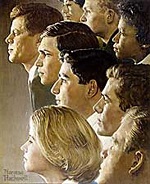Let the Word Go out…JFK50–Remembering March 1,1961
[Thanks to Marian Haley Beil (Ethiopia 1962-64) we have this blog item.]
This remix of JFK’s inaugural speech is very moving. The message is just as real as it was then. It includes two RPCVs.
Along the right side of the main film screen is smaller screens with interviews with the speakers. If you link to the Peace Corps films more will come up on the right including JFK talking about the Peace Corps in March ’61 – and others RPCVs speaking about the Peace Corps.
JFK50: Let the Word Go Forth
“Let the Word Go Forth” is a film of many faces and voices re-creating President John F. Kennedy’s inaugural address. 
http://www.youtube.com/watch?v=qqnRRO3zziI&list=EC0C8EA12816C44568
Executive Order 10924: Establishment of the Peace Corps. (1961)
The founding of the Peace Corps is one of President John F. Kennedy’s most enduring legacies. Yet it got its start in a fortuitous and unexpected moment. Kennedy, arriving late to speak to students at the University of Michigan on October 14, 1960, found himself thronged by a crowd of 10,000 students at 2 o’clock in the morning. Speaking extemporaneously, the Presidential candidate challenged American youth to devote a part of their lives to living and working in Asia, Africa, and Latin America. Would students back his effort to form a Peace Corps? Their response was immediate: Within weeks, students organized a petition drive and gathered 1,000 signatures in support of the idea. Several hundred others pledged to serve. Enthusiastic letters poured into Democratic headquarters. This response was crucial to Kennedy’s decision to make the founding of a Peace Corps a priority. Since then, more than 168,000 citizens of all ages and backgrounds have worked in more than 130 countries throughout the world as volunteers in such fields as health, teaching, agriculture, urban planning, skilled trades, forestry, sanitation, and technology.
By 1960 two bills were introduced in Congress that were the direct forerunners of the Peace Corps. Representative Henry S. Reuss of Wisconsin proposed that the Government study the idea, and Senator Hubert Humphrey of Minnesota asked for the establishment of a Peace Corps itself. These bills were not likely to pass Congress at the time, but they caught the attention of then-Senator Kennedy for several important reasons. In contrast to previous administrations, Kennedy foresaw a “New Frontier” inspired by Roosevelt’s New Deal. The New Frontier envisioned programs to fight poverty, help cities, and expand governmental benefits to a wide array of Americans. In foreign affairs, Kennedy was also more of an activist than his predecessor. He viewed the Presidency as “the vital center of action in our whole scheme of government.” Concerned by what was then perceived to be the global threat of communism, Kennedy looked for creative as well as military solutions. He was eager to revitalize our program of economic aid and to counter negative images of the “Ugly American” and Yankee imperialism. He believed that sending idealistic Americans abroad to work at the grass-roots level would spread American goodwill into the Third World and help stem the growth of communism there.
Kennedy lost no time in actualizing his dream for a Peace Corps. Between his election and inauguration, he ordered Sargent Shriver, his brother-in-law, to do a feasibility study. Shriver remembered, “We received more letters from people offering to work in or to volunteer for the Peace Corps, which did not then exist, than for all other existing agencies.” Within two months of taking office, Kennedy issued an Executive order establishing the Peace Corps within the State Department, using funds from mutual security appropriations. Shriver, as head of the new agency, assured its success by his fervent idealism and his willingness to improvise and take action. But to have permanency and eventual autonomy, the Peace Corps would have to be approved and funded by Congress. In September 1961, the 87th Congress passed Public Law 87-293 establishing a Peace Corps. By this time, because of Kennedy’s Executive order and Shriver’s leadership, Peace Corps volunteers were already in the field.
For more information, visit the National Archives’ Digital Classroom Teaching With Documents Lesson Plan: Founding Documents of the Peace Corps and the Peace Corps web site.
Dear Marian and John,
Thank you so much for finding and posting this beautiful video. The short videos listed on the right side of the screen that you cited are an important piece because they show how the elegance of the speech was translated into action.
So powerful! I kept thinking as I listened to those words, “How did I get so lucky to be alive in that time and space?”